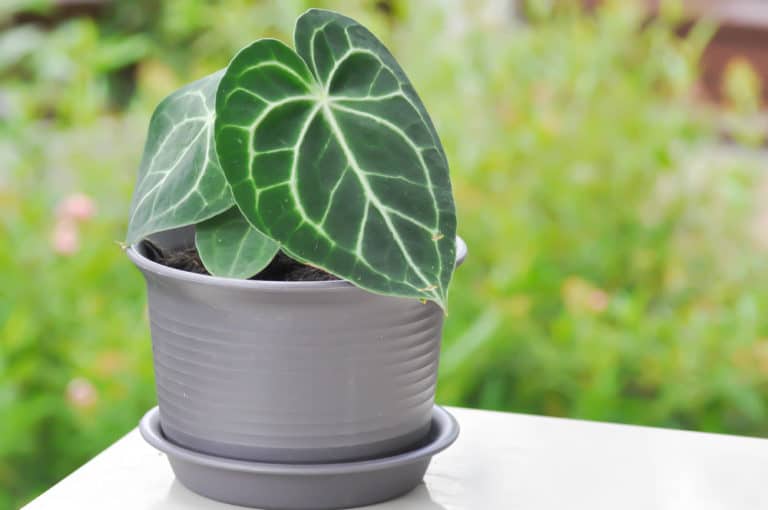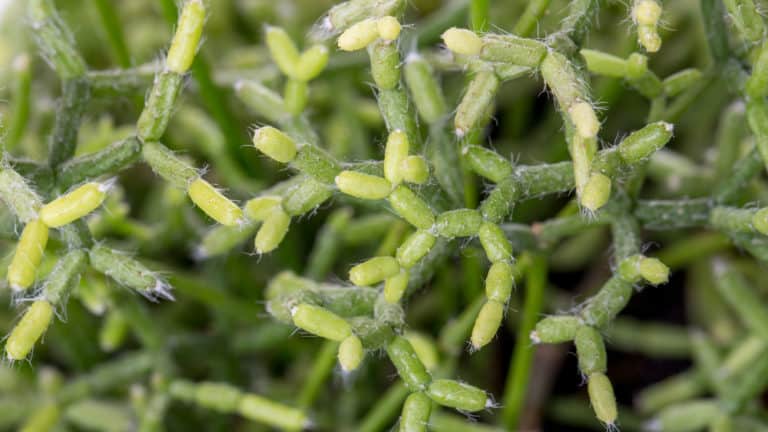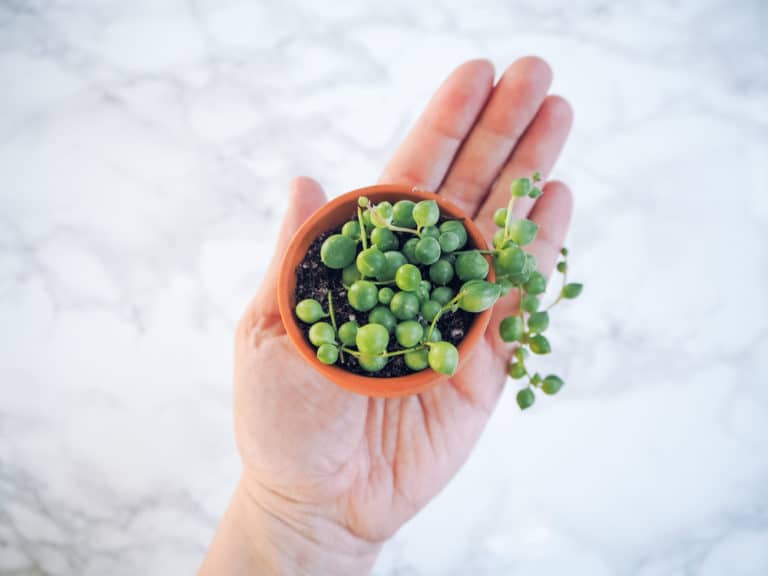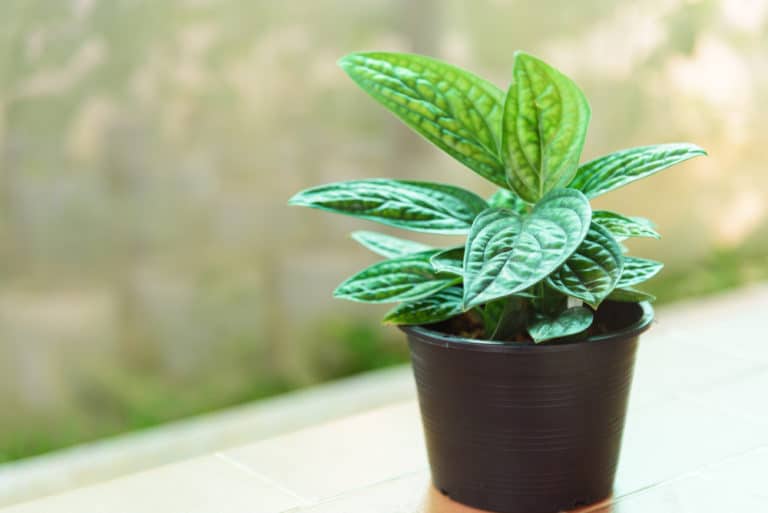Kalanchoe Delagoensis ‘Mother of Millions’ Care (2024)
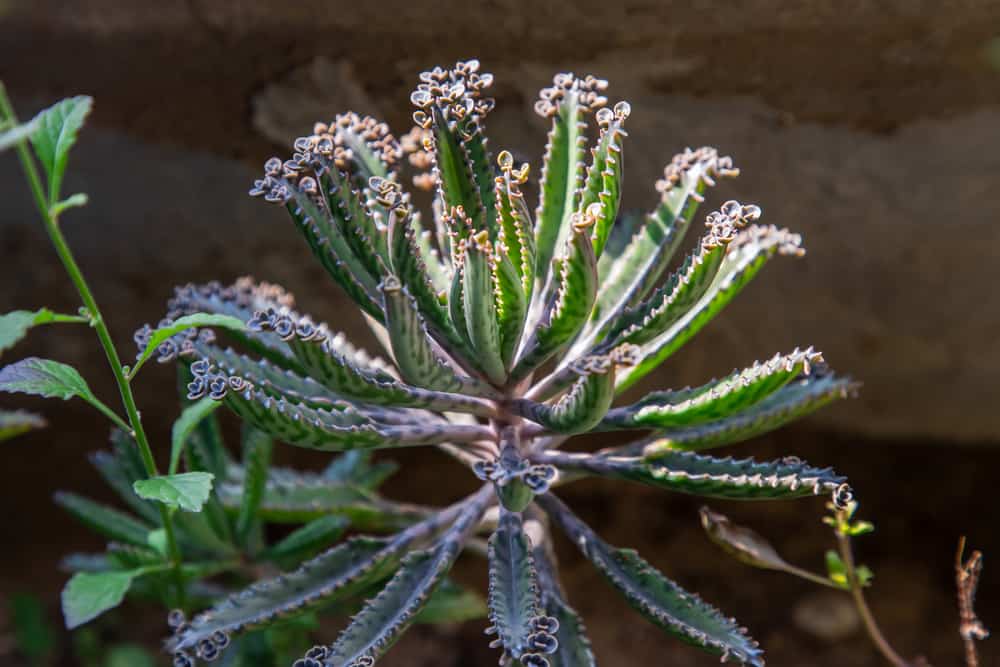
Mother of millions, or Kalanchoe delagoensis, is a fast-growing, low-maintenance succulent with a unique look for your home or garden.
Also known as the Chandelier plant, it is a great foliage plant with its spiky leaves. As well, in winter and early spring you may get a great show of flowers on your houseplant.
| Scientific Name | Kalanchoe delagoensis |
| Common Name | Mother of Millions, Chandelier Plant, Mexican Hat |
| Light | Direct sunlight |
| Watering | Water when soil is completely dry |
| Temperature | 60 to 85ºF (15 to 29ºC) |
| Hardiness Zone | 10 to 12 |
| Humidity | 40 to 50% |
| Soil Type | Sandy, quick-draining |
| Soil pH | 6 to 6.5 (mildly acidic) |
| Fertilizing | A balanced feed once a month in spring and summer |
| Repotting | Every 2 years |
| Pruning | Spring and summer |
| Propagation | Root in soil or with seed |
| Toxicity | Toxic to humans and pets |
| Mature Size | 42 inches as a houseplant |
| Bloom Time | Winter |
What’s Unique About Mother of Millions?
The mother of millions plant is native to the dry regions of central and south Madagascar, where it grows in the arid savanna.
Mother of millions plants can now be found across the tropical and subtropical regions of the world. In fact, it spreads so rapidly that it has been declared a noxious weed in places such as Australia and Florida.
As you might imagine, growing mother of millions is pretty easy, and it doesn’t require a whole lot of attention to grow fast.
Be warned, however; this fascinating succulent is toxic, especially to your pets, and should be grown with caution.
Mother of Millions Care
In the savannas of Madagascar where Kalanchoe delagoensis originates, this succulent plant thrives in an arid environment.
This makes mother of millions plant care fairly easy, as it does not need constant watering and high humidity.
In fact, your Kalanchoe delagoensis care may end up focusing on how to keep this enthusiastic spreader contained.
Light
Mother of millions has evolved in a sunny environment with little shade. The native savanna of Kalanchoe delagoensis is a grassland, where trees are few and far between.
Mother of millions light requirements are for bright light, up to and including full sun.
You should find a sunny spot by a south, east, or west window to set this plant, to meet your Kalanchoe delagoensis light needs.
However, in summer it’s best to keep it out of the full sun, as the bright rays coming through the glass could damage the foliage.
A northern exposure will simply not provide enough light to let your Kalanchoe delagoensis thrive. You can use a plant light if that’s the only window you have.
Watering
In the dry region of Madagascar, rainfall is infrequent and sparse, even in the summer wet season. In the winter, it rarely rains at all.
That’s why Kalanchoe delagoensis has evolved as a succulent plant, storing water in its leaves to weather the dry periods. Your mother of millions watering should reflect its native conditions.
Only water Kalanchoe delagoensis when the soil has completely dried out. It’s easy to tell when the pot has become very lightweight.
The best way to meet your Kalanchoe delagoensis watering needs is to set the pot in a pail of tepid water and let it get fully saturated. Then, allow all the excess water to drain out before setting the pot back in its saucer.
Temperature
The year-round temperature range in central and south Madagascar has highs around 79 to 85ºF (26 to 30ºC), and lows from 63 to 75ºF (17 to 24ºC).
In your home, the acceptable mother of millions temperature range is from 60 to 85ºF (15 to 29ºC).
You should have no trouble providing an adequate temperature for Kalanchoe delagoensis at normal room temperatures in winter. Moving it outdoors in summer can give it an extra shot of heat, but beware of it spreading its plantlets far and wide.
Its temperature tolerance falls off below 50ºF (10ºC), so if temperatures drop under that, it will stop growing.
It does have limited frost hardiness, but extended periods of freezing temperatures will kill it.
Humidity
Your mother of millions humidity requirements are generally low, despite the fact that the humidity in its native environment hovers around 80%.
The ideal humidity for Kalanchoe delagoensis is probably between 40 to 50%, although it will not suffer at a humidity level as low as 20%.
It will, however, grow faster at the higher range. A pebble tray filled with water and set under the pot should suffice to keep levels reasonable.
In fact, it is recommended that you do not set your Kalanchoe delagoensis too close to a humidifier, so that its immediate environment is not too moist.
Soil
Your mother of millions soil should be very loose and well-draining, as this succulent will simply not tolerate wet soil.
The required pH level for Kalanchoe delagoensis is between 6 to 6.5, or mildly acidic.
The easiest soil for Kalanchoe delagoensis is a commercial cactus or succulent soil mix, which is pretty widely available.
However, you can also modify a standard potting soil by adding an equal quantity of sand, with a couple of handfuls of perlite to further loosen up the mix.
You may be shocked at how easily Kalanchoe delagoensis plantlets will adapt to almost any available soil, or even gravel. Still, for the best results, you should strive to give it ideal soil conditions.
Fertilizer
You do not need to use mother of millions fertilizer at all if you wish, but for optimum growth a moderate amount of feeding throughout the growing season is preferable.
Look for a fertilizer for Kalanchoe delagoensis with a fertilizer ratio of 3-1-3, with added calcium, magnesium, manganese, and iron.
A specialty cactus fertilizer will be able to supply most of the essential nutrients to your Kalanchoe delagoensis.
Apply once a month in spring and summer, and then stop until your Kalanchoe delagoensis sets flower buds in winter. Then use a fertilizer with a 3-1-4 ratio until the flowering is finished.
Always add the fertilizer right after you’ve watered your Kalanchoe delagoensis so that it doesn’t just run through the soil.
Potting & Repotting
Mother of millions repotting should be undertaken every couple of years.
This plant is a vigorous and rapid grower. You will know when it’s time for repotting Kalanchoe delagoensis when you see its roots snaking out of the drainage holes, or filling up the pot.
You should only increase the pot size by a couple of inches in diameter each time, as too much soil will stay wet for too long.
Definitely use a terracotta pot for your Kalanchoe delagoensis, as it will help keep the soil on the dry side. A glazed or plastic pot won’t let the soil breathe.
Even if your Kalanchoe delagoensis hasn’t become rootbound, replacing the potting soil with a fresh mix is a good way to prevent the build-up of disease in the soil.
Pruning
You may choose to not do any mother of millions pruning, and that’s okay.
Cutting Kalanchoe delagoensis is not essential to maintain a healthy plant, and if you have room to let it grow, go for it.
However, if you want to encourage bushier growth instead of height, simply cut the main stem wherever you want, right above a large leaf. New growth will then form at the bottom of the plant.
This should be done in spring or summer when it’s actively growing.
Trim off the flowers after they’ve faded to encourage new flowers and prevent it from setting seeds.
Propagation
Mother of millions propagation is so easy that your main concern will probably be how to curb its unassisted reproduction.
The usual method to propagate Kalanchoe delagoensis is by planting out the little plantlets that form all along the edges of the leaves.
All you have to do is pluck them off and set them on moist soil, and they will root enthusiastically.
In fact, even if you don’t remove them, they will fall off and take root wherever they fall.
You can take stem cuttings and root them in water or soil, as well, for a faster route to full-grown plants.
Common Problems of Mother of Millions
There are not many mother of millions problems to deal with.
In fact, you won’t have problems with Kalanchoe delagoensis if you just pay attention to its needs.
However, if the leaves of this succulent plant start to look under the weather, clearing up the issue quickly is the best way to ensure its long-term survival.
Pests
You may find any of the most common houseplant bugs on your Kalanchoe delagoensis.
However, most mother of millions pests can be deterred by using an insecticidal soap or neem oil solution on the leaves every month.
Mealybugs can be found in cottony masses on the leaves and stems. Scale insects look like brown bumps. Remove them both with rubbing alcohol.
Aphids are small green insects that feed enthusiastically on the sap. Spider mites are hard to see, but their webs and the yellow bumps they leave on the leaves are obvious. Rinse off both these bugs with a good showering.
Diseases
There are very few mother of millions diseases to worry about.
However, your Kalanchoe delagoensis may develop black mildew on its leaves, caused by air that is too dry. Use a fungicidal spray, and increase the humidity levels around your plant.
Root rot is likely to develop when the soil of your Kalanchoe delagoensis is too wet. The leaves will get soft and yellow, and the stems will soften. If the roots are turning black with a bad smell, you need to cut off everything that’s affected and replant what’s left in fresh soil.
If it’s too advanced, you may have to start anew with a few of those little plantlets.
Growing Problems
Avoid growing problems by raising your Kalanchoe delagoensis in the conditions that it needs to thrive.
However, if you do have a sick plant, changing how you’re growing it should do the trick.
Brown or curling leaves (or both!) are usually a sign of sunburn or drought.
While Kalanchoe delagoensis likes full sun and dry soil, in summer it’s best to keep out of the direct sun. You also need to water it just as the soil has dried out.
Wrinkled leaves indicate that you’re giving it too much water. Don’t add more until the soil is dry.
Legginess means that your Kalanchoe delagoensis needs more direct light.
Toxicity of Mother of Millions
Kalanchoe delagoensis is mildly toxic to humans, and can have more severe consequences for animals, including cats, dogs, and horses.
Its toxicity is caused by the bufadienolides found in all parts of the plant, but especially in the flowers. They can cause mild intestinal upsets, or in severe cases heart failure.
For Humans
Kalanchoe delagoensis is usually considered mildly toxic to humans, but in rare instances can cause severe illness, especially in children.
Merely coming into contact with the plant, or even getting the sap on your skin, will have no adverse effect.
However, ingesting any part of the plant, but especially the flowers, can cause stomach upset, abdominal cramps, vomiting, diarrhea, and most seriously, heart palpitations or heart failure.
Children are more at risk because a harmful dose is lower than for an adult, because of their smaller body mass.
If your child eats some of the Kalanchoe delagoensis foliage or flowers, take them to the emergency room.
For Pets
Your pets are definitely at risk of a serious complication if they eat any part of a Kalanchoe delagoensis plant.
In fact, if they eat too much of it, they can die of cardiac failure.
Minor symptoms include vomiting and diarrhea. However, if you know that your pet has eaten some of your Kalanchoe delagoensis, it is best to take them to the veterinarian for expert treatment.
If you have pets who may be inclined to nibble on plants, you should probably think twice before growing it either indoors or outside.
If you do decide to grow Kalanchoe delagoensis, be sure to erect some form of barrier to keep it away from your pets and children.
Mother of Millions Appearance
The unique mother of millions appearance makes it a very different sort of houseplant for indoor gardeners.
Its succulent leaves grow on a plant more than 3 feet tall. Between the plantlets that grow along the leaf edges and the winter flowers, they have a great deal of visual interest.
Foliage
The foliage of mother of millions is certainly different, even from other succulents. It practically looks like an alien plant.
Each leaf is tubular, and 3 to 6 inches long.
They have 3 to 9 projections or “teeth” at the tip, between which the plantlets form. The upper surface has a groove down the middle.
Plants that grow in moister, shadier locations have wider, flatter leaves, while the leaves of plants growing in sandy soil in the hot sun are almost perfectly round.
Leaves are gray-silver or green in color, with a waxy surface. They have markings similar to a snakeskin.
Flowering
The gorgeous Kalanchoe delagoensis flower is a bonus of growing this subtropical succulent.
Mother of millions flowering is more likely on plants that are grown outside, but you can stimulate blooming on indoor plants with some luck.
Make sure it gets lots of bright light, and fertilize it regularly. In early winter, keep it at about 40⁰F (4⁰C) before bringing it back into a warm environment in late winter.
The flowers are worth the trouble. Huge clusters of bell-shaped flowers hang down from the tops of the stems, in shades of red to gold, and last for up to 5 weeks.
If you clip off the dead blossoms, your Kalanchoe delagoensis may reflower.
Size and Growth
The size of mother of millions depends on where it is grown. Indoors, they usually top out at about 40 inches, while a plant grown outdoors can reach 6 feet.
Kalanchoe delagoensis has a very rapid growth rate and can reach its full size in one growing season.
Because it self-propagates so readily, it is strongly advised that you do not grow Kalanchoe delagoensis outdoors, whether in a pot or in the ground.
It has become a noxious weed in many locales across the world, and its seeds and plantlets can spread far and wide, even if the plant itself is confined in a container.
Mother of Millions Fragrance
While your Kalanchoe delagoensis may produce gorgeous flowers, they have no scent. As the foliage is also without a scent, this means that there is no mother of millions fragrance.
That’s not entirely a bad thing. Because many people have a sensitivity to strong scents, even pleasant ones, it’s best that plants used in a building open to the public have no fragrance.
Kalanchoes actually have a very positive impact on your home’s air quality. They are nocturnal oxygenators.
This means that unlike many other plants, they absorb carbon dioxide during the day, but don’t release the oxygen they’ve made until night time.
Suggested Uses for Mother of Millions
It’s best to grow your Kalanchoe delagoensis indoors, as the invasive nature of this plant has made it a menace to many natural habitats. Even growing it in a pot is not enough to curb its propagation by plantlets and seeds.
However, find your Kalanchoe delagoensis a sunny spot by a south window and it will be perfectly happy indoors.
Because it’s a nocturnal oxygenator, if you grow a Kalanchoe delagoensis in your bedroom, you will get fresh oxygen while you sleep.
Its interesting architectural shape will contrast well with large-leafed or ferny tropical plants in a varied grouping of plants, while it can also make an interesting solo planting.
FAQ
What is mother of millions?
Mother of millions is a succulent evergreen bush which is native to the subtropical savanna of southern Madagascar, where it grows in the arid grasslands.
How to identify mother of millions?
Mother of millions grows into a tall shrub with long, narrow, tubular leaves. The leaves develop plantlets at the tips, and large clusters of bell-shaped flowers grow from the tops of the stems.
How to care for mother of millions?
Mother of millions should be grown in loose, well-draining soil, in a bright, sunny location, with infrequent watering and feeding at normal room temperature and humidity levels.
How to grow mother of millions indoors?
Mother of millions can be grown as a potted plant in full sun to bright indirect light, with low to moderate humidity and temperatures above 60ºF (15ºC).
How to grow mother of millions outdoors?
Mother of millions is not recommended for growing outdoors, as it has escaped from cultivation and now grows wild as a noxious weed in many places across the globe.
How fast does mother of millions grow?
Mother of millions has a very rapid growth rate, and will easily reach its full size within one growing season, whether it’s grown from stem cuttings or plantlets.
How tall does mother of millions grow?
Mother of millions will usually stop at about 40 inches when grown inside as a potted plant, although plants grown outdoors can easily reach 6 feet.
How to make mother of millions grow faster?
Mother of millions already grows very fast, but giving it bright light and hot temperatures similar to its native habitat will help it put on extra speed.
How to stake mother of millions?
Mother of millions does not need to be staked to remain upright, but if it becomes top-heavy, simply cut off the top of the stem as far down as desired.
How to pot mother of millions?
Mother of millions should be potted in an extremely loose and porous soil, such as a cactus mix, in a terracotta pot with drainage holes.
How to revive mother of millions?
Mother of millions is extremely resistant to drought, but if its succulent leaves become brown or curled, they need water. Soak the pot in a pail of water until the soil is saturated.
Why is my mother of millions dying?
Your mother of millions may have root rot from overwatering. Try cutting off all the parts showing signs of stress or infection, and replant it in fresh soil.
Why is my mother of millions drooping?
Your mother of millions may be getting top-heavy from too much foliage up top. Simply cut off the stem to encourage more growth towards the bottom of the plant.
How cold can mother of millions tolerate?
Mother of millions can tolerate brief periods of frost, and temperatures around 40ºF (4ºC) can encourage flowering, but extended lengths of time below 50ºF (10ºC) will halt growth.
How to get rid of pests on mother of millions?
Mother of millions pests such as mealybugs can usually be kept away with regular sprays or wipe-downs with an insecticidal soap or neem oil mixture.
Is mother of millions toxic to cats?
Yes, mother of millions is toxic to cats. Mild poisoning can cause vomiting and diarrhea, while more severe cases can lead to cardiac arrest and death.
Is mother of millions toxic to dogs?
Yes, mother of millions is toxic to dogs. If your dog ingests some of the foliage or flowers, you should take it to the veterinarian as soon as possible.
Is mother of millions toxic to children?
Yes, mother of millions is toxic to children. While usually the only symptoms are vomiting or diarrhea, it is possible that ingesting the leaves or blooms can cause heart problems.
Is mother of millions toxic to humans?
Yes, mother of millions is toxic to humans. It is not a skin irritant, but ingesting large quantities of the plant material can have serious consequences.
Does mother of millions have a scent?
Mother of millions does not have a scent, even when the flowers are in bloom. It is appropriate for use in places where people with fragrance allergies may be exposed to them.

